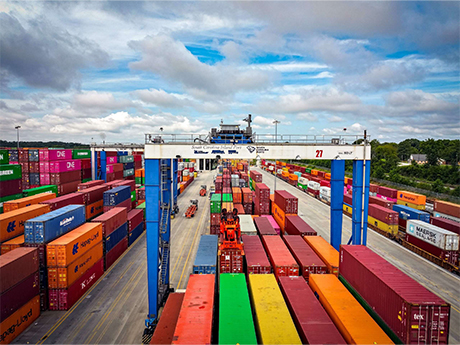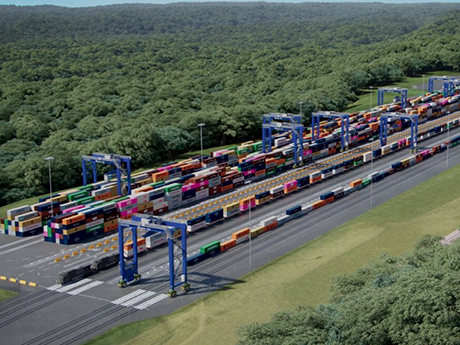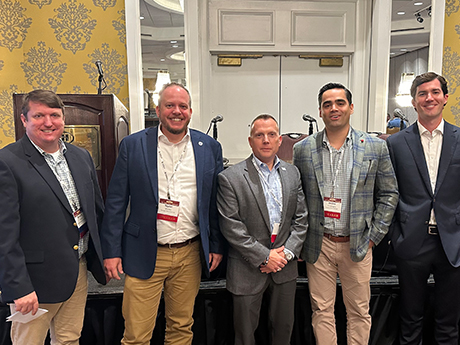CHARLOTTE, N.C. — Inland ports are a growing transportation option in the national supply chain. These facilities provide users — including automotive suppliers, retailers, manufacturers and agricultural producers — an option to import and export their wares to seaports via shipping containers by rail as opposed to trucking their products directly to a port terminal.
One of the more prominent inland ports in the country is Inland Port Greer in Upstate South Carolina. The facility’s anchor client is BMW, which operates its mega manufacturing campus in nearby Spartanburg, S.C. Class I freight railroad operator Norfolk Southern Corp. provides rail services from the inland port to the Port of Charleston.
Brian Gwin, senior industrial development manager for Norfolk Southern, said that when the railroad operator and the South Carolina Ports Authority (SCPA) established Inland Port Greer in 2013, it was apparent almost immediately that they had a behemoth on their hands.
“We knew it was going to be mostly BMW, but we designed Inland Port Greer for 50,000 lifts a year,” said Gwin, referring to the number of shipping containers moved on or off Norfolk Southern trains at the inland port. According to multiple media outlets, the inland port exceeded 100,000 lifts by 2016.
“Once we opened, it opened the floodgates of opportunities in and around that area,” said Gwin. “We had new warehousing come in as well as existing tenants in the area that decided to take advantage of it. Today, Norfolk Southern and the port authority have been engaged in a multi-year expansion of the facility and the rail capabilities.”

Gwin’s comments came during a panel on port activity at InterFace I-85 Industrial Corridor, an annual conference hosted by InterFace Conference Group and Southeast Real Estate Business. The two-day networking and information event was held on May 20-21 at the Hilton Charlotte Uptown and attracted nearly 400 attendees. Dillon Swayngim, vice president of industrial services at Colliers’ Spartanburg office, moderated the discussion.
Growth of inland ports
The panelists — three of whom hold positions at state port authorities in the Southeast — spent the bulk of the discussion speaking about the growth and dynamism that they’ve experienced at their respective inland ports.
Taylor Worley, assistant manager of market research and economic development at Georgia Ports Authority (GPA), said that the port authority’s newest inland port is Appalachian Regional Port, which opened in northwest Georgia in 2018. The 40-acre property is rail-served by CSX Corp., which transports shipping containers directly to the Port of Savannah.
“The inland port is designed to have an annual maximum lift capacity of about 75,000,” said Worley. “We’re having record years at the port — right now we are probably at about 60 percent of that capacity.”
Worley also said that inland ports are directly influencing major advanced manufacturers during site selection. He said that when looking for its multibillion-dollar campus, SK Battery America originally was touring sites in and around the Port of Savannah.
That is until the South Korean battery manufacturer got wind of Blue Ridge Connector, GPA’s newest inland port coming to Hall County in northeast Georgia. SK Battery ultimately decided to build its battery plant in nearby Commerce, Georgia, which will eventually offer direct access to the $134 million inland port via I-85.
“SK is going to be supplying a lot of these businesses across Georgia,” said Worley.
GPA and Norfolk Southern are on schedule to open Blue Ridge Connector in spring 2026.
“Blue Ridge Connector at full build-out will have the capacity for 200,000 lifts,” said Worley. “That’s when it will have its full complement of 14 cranes — we’ll start off with six or seven. We expect the great potential for growth around that market with access along I-85, with the forces in Savannah encouraging more growth inland.”

Worley also said that GPA also owns land in LaGrange, a city in Georgia near the Alabama border along I-85. He said that Kia, which has a major manufacturing hub in nearby West Point, Georgia, will be the anchor tenant of the inland port down the line.
“We don’t have a date for the West Central Georgia inland port yet,” said Worley.
Gwin said that Norfolk Southern is also “planting seeds” for more of its intermodal facilities, which are similar to inland ports but the land is not owned by port authorities. He described the site selection process as a “chicken-or-the-egg situation.”
“It’s hard to put the asset in place until the freight is there, but the freight doesn’t want to go there until the asset is there,” said Gwin.
ESG implications
The panelists mentioned that industrial users are turning to inland ports because they have certain thresholds that they’re trying to achieve, not all of which are financial. Corporations are more attuned now to their ESG standards, or environmental, social and governance initiatives.
Travis Frank, who handles business development for SCPA, said that tire manufacturing giant Michelin, which operates several large-scale manufacturing plants in South Carolina, recently put out a request for proposal (RFP) for a new facility that has an ESG component.
“In Michelin’s RFP, it needs to hit certain numbers,” said Frank. “The distance from Charleston to Greer on rail versus truck is about a 90 percent carbon emissions savings in that portion of the move. We are seeing more companies look at the inland ports versus trucks as a way to hit those [ESG] goals.”
On the governance front, inland ports are also helping customers by being a soft launch destination for new initiatives. Worley gave an example at the Appalachian Regional Port.
“GE decided to locate its Southern Logistics Center right down the road. That has allowed GE to experiment with electric semis by bringing those trucks on that short, simple dray,” said Worley. (Dray refers to hauling shipping containers via truck to or from a port.)
“If you had a new technology like that, you would not feel comfortable doing it driving through downtown Atlanta or on a 300-mile trip,” said Worley. “[Inland ports] allow companies to take a lower risk and experiment on new technologies by having the shorter drays.”
The panelists mentioned that users are also finding that using inland ports and intermodal facilities are helping the trucking industry. Aaron Brott, senior director of key client and trade development at North Carolina State Ports Authority, said that there’s a severe trucking shortage at the moment.
“Drivers are aging out of the industry,” said Brott.
“We are in a historic trucking recession right now,” added Gwin.
Worley said that one advantage of utilizing inland ports is that truck drivers can make shorter but more frequent deliveries, plus have better quality of life.
“A typical trucker is used to having to sleep at a truck stop or on the side of the road,” said Worley. “Truckers delivering from places like SK Battery can now ship four or five boxes a day as opposed to one, plus you can tell them that they can sleep in their own bed that night. It makes it an easier and more attractive job, which extends their careers and maybe opens up employment opportunities for younger folks and women.”
The panelists agreed that ultimately users want optionality in their supply chain, with the inland ports providing a logistical solution.
“Cargo owners demand flexibility in their supply chain,” said Frank. “They don’t want to put all their eggs in one basket but find alternative entry points. We’re going to continue to see that moving forward.”
— John Nelson


